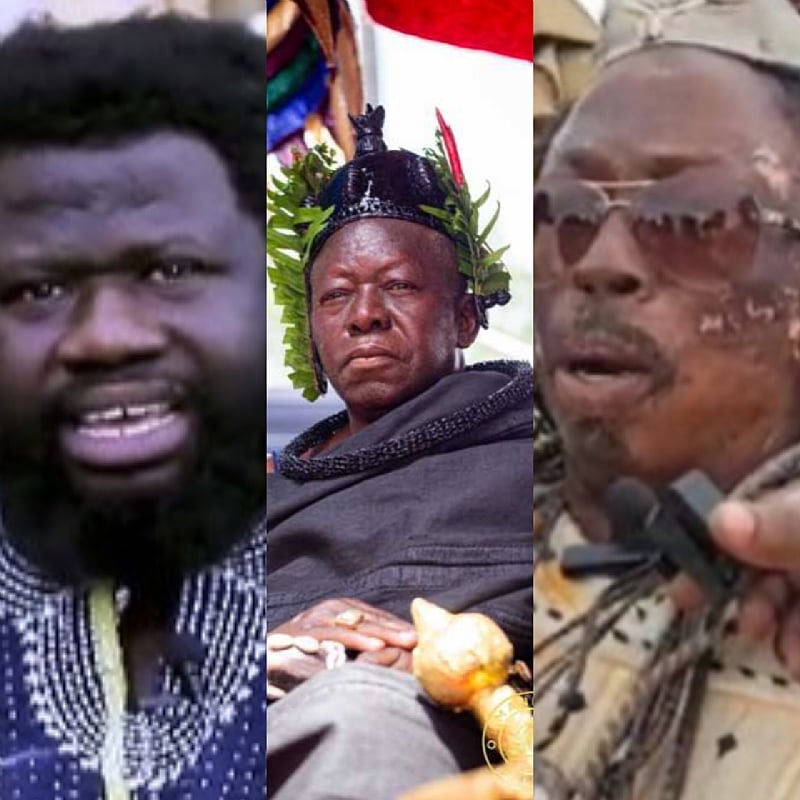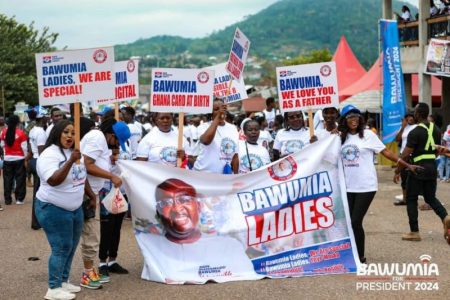The recent incident involving traditional priest Nana Kwaku Bonsam and the Asantehene, Otumfuo Osei Tutu II, has ignited a public debate centered around spiritual authority, tradition, and social hierarchy. A viral video captured Bonsam being prevented from approaching the Asantehene at a public function, an act that has been interpreted by some, including spiritual pastor Azuka, as a sign of Bonsam’s diminished spiritual influence. Azuka’s assertion that Bonsam’s inability to greet the Asantehene is proof of his waning powers has fueled the controversy, prompting Bonsam to vehemently defend his spiritual standing and question the rationale behind being barred from interacting with the revered monarch. This clash of perspectives highlights the complex interplay between traditional beliefs, social protocols, and the perceived authority of religious figures in Ghanaian society.
The core of the controversy stems from the contrasting interpretations of the incident. Azuka views Bonsam’s blocked approach as definitive evidence of his spiritual decline. He argues that a truly powerful spiritualist would not be subject to such restrictions, especially considering Bonsam’s reputation as a prominent fetish priest. Azuka’s interpretation rests on the assumption that spiritual power translates into social privilege and access, implying that a potent spiritual force should transcend social barriers and protocols. This perspective reflects a belief system where spiritual prowess allows individuals to circumvent established norms, even within the highly structured context of traditional chieftaincy. By highlighting the fact that even a child was permitted to greet the Asantehene, Azuka further emphasizes what he perceives as the incongruity of Bonsam’s situation, implying a significant loss of spiritual standing.
Conversely, Kwaku Bonsam contests this interpretation, expressing indignation at being prevented from greeting the Asantehene, particularly in light of the fact that Christian pastors were apparently granted access. He positions himself as a senior priest, suggesting a hierarchical understanding of religious authority where his position should afford him the same, if not greater, access to the Asantehene as other religious leaders. This highlights a potential conflict between different forms of religious practice and their relative status within the traditional framework. Bonsam’s argument implies that the established protocols did not adequately recognize his position within the spiritual landscape, raising questions about the criteria used to grant access and the relative importance assigned to different religious traditions. His frustration underscores the complexities of navigating cultural and religious sensitivities within a pluralistic society.
The incident has further ignited discussions surrounding the nature and demonstration of spiritual power. Azuka’s assertion that Bonsam’s power has faded relies on a very public and demonstrable interpretation of spiritual influence. The inability to overcome the social barriers preventing him from greeting the Asantehene becomes, in Azuka’s view, a direct reflection of a weakened spiritual capacity. This suggests a belief that spiritual power manifests in tangible, observable ways, influencing social interactions and enabling individuals to circumvent established norms. This perspective reduces spiritual influence to a performance of power, equating social access with spiritual potency.
However, alternative interpretations of spiritual power challenge this perspective. Some might argue that true spiritual strength resides in less overt manifestations, focusing on inner peace, wisdom, or community impact rather than social maneuvering. From this perspective, being prevented from greeting the Asantehene may have no bearing on Bonsam’s spiritual status. This perspective de-emphasizes the importance of public displays of power and highlights the internal and often less visible aspects of spiritual practice. This nuanced understanding of spiritual influence moves beyond the simplistic equation of social access with spiritual potency.
The controversy surrounding Kwaku Bonsam and the Asantehene underscores the intricate relationship between traditional belief systems, social hierarchies, and the evolving landscape of religious practice in Ghana. The incident has sparked a debate about the nature of spiritual authority, the criteria used to assess its legitimacy, and the interplay between different religious traditions within a complex cultural context. While Azuka interprets the incident as a sign of Bonsam’s declining influence, Bonsam’s own perspective highlights a potential tension between different forms of spiritual practice and their relative status within the traditional framework. This ongoing discourse reflects the broader challenges of navigating cultural and religious sensitivities in a society where traditional beliefs coexist with evolving practices, prompting questions about the evolving definition of spiritual power and its manifestations in the public sphere.














